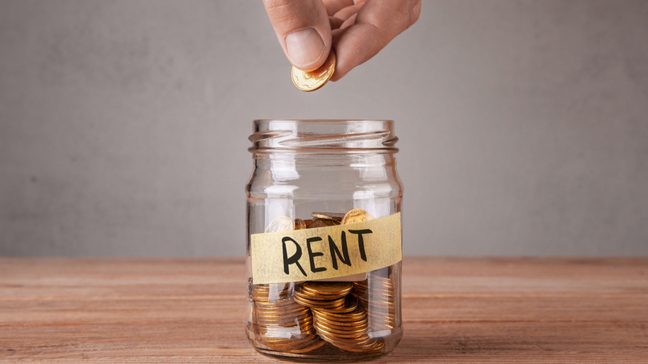When shopping for a wedding dress, I was given some sound advice: don’t try it on if you can’t afford it. Because if you fall in love with it, you will either be heartbroken when you can’t have it or you’ll blow your budget to get it.
What I love about this advice is that it is applicable to more than just wedding dress shopping.
For example, it works just as well when figuring how much rent you can afford. After all, the last thing you want to do is find your dream apartment only to discover it’s way out of your budget.
What’s Ahead:
Determine How Much Rent You Can Afford
Here are some rules of thumb to use when determining how much of your income should go to rent:
The 30% Rule
This rule is about as quick and easy as it gets when trying to decide how much you can afford to spend on rent: you should spend about 30% of your gross monthly income (before taxes) on rent.
Keep in mind the 30% rule doesn’t include utilities or any other housing expenses — it’s 30% of your gross income on rent alone.
So, if you bring home $3,000 per month, then you should aim to spend around $900 (or less) on your monthly rent ($3,000 x 0.30 = $900).

Source: Giphy.com
Keep in mind, this is just a general rule. The 30% rule is a good starting point, you may still need to adjust this figure based on what works best for you.
For example, if you live in a city with high rental prices, then you might be required to pay more than 30% just to find housing.
On the other hand, if you have student loan payments or other loans, then spending 30% on rent might be too high for your monthly budget.
Read more: How To Manage Student Loan Debt
The 30% rule has its origins in 1937 and the U.S. National Housing Act, which created the public housing program for low-income families. Income limits were established as eligibility for families that wanted to live in public housing. Back then, the rule was that, “a tenant’s income could not exceed five to six times the rent.”
Since then, the limit has increased. In 1961, the Housing and Urban Development Act established that the rent threshold should not exceed 25% of a family’s income. This was then raised to 30% in 1981 — a benchmark that’s since stayed the same.
The 50/30/20 Budget Rule
Another simple rule for determining how much of your income should go to rent is the 50/30/20 budget. This rule states you cam use 50% of your net income (after taxes) for your “needs.” Your needs include things like housing, utilities, car payments, and groceries.
Next, allot 30% of your monthly income for wants — things like clothing, eating out, and hobbies.
The remaining 20% should go towards saving, investing, and debt repayment.

Source: Giphy.com
So, if you bring home $3,000 per month after taxes, this would give you $1,500 per month to spend on your needs, $900 for wants, and $600 for saving, investing, and debt repayment:
- To calculate 50% ($3,000 x 0.50 = $1,500).
- To calculate 30% ($3,000 x 0.30 = $900).
- To calculate 20% ($3,000 x 0.20 = $600).
Remember, the 50% is for all your needs, not just your rent alone. So make sure you have a good idea of how much you spend per month on things like food and utilities before deciding the exact amount you can put towards rent.
For help calculating your 50/30/20 budget, check out our handy 50/30/20 calculator.
The 50/30/20 rule was popularized by Senator Elizabeth Warren and her daughter Amelia Warren Tyagi in their book, “All Your Worth: The Ultimate Lifetime Money Plan.”
Other Considerations besides the Rent Price
While these rules of thumb are helpful starting points for determining how much rent you can afford, there are several other factors to consider — such as other expenses associated with renting, where you want to live, how much debt you have, and the kind of lifestyle you want.
Additional Costs Associated With Renting
Your monthly rent payment will likely be your largest housing expense, but it’s not the only expense. Often landlords require all sorts of extras. Here are some other things you’ll need to factor in:
- Moving costs.
- Security deposit.
- Pet deposit.
- Utility payments.
- Renters insurance.
- Parking.
- Commuting costs.
Where Do You Want to Live?
If you’re looking in a high-cost-of-living city like San Francisco, where the average cost of a one-bedroom apartment is $2,995, then you might have to spend more than the recommended benchmark amount (or get four roommates).
On the other hand, if you’re looking for a place in a low-cost-of-living city and you make a high salary, you might spend less.
How Much Debt Do You Have?
You also have to consider how much debt you are carrying. If you are completely debt-free, then you might be able to pay a little more to your rent.
If you are drowning in student loans and credit card debt, then you probably need to be putting more of your income towards debt repayment.
Read more: How to Pay Off Credit Card Debt Fast
What Kind of Lifestyle Do You Want?
This is very important: don’t forget to think about the type of life you want to live. Your spending habits and other financial goals matter.
If you enjoy going out for dinner or spending extra money on hobbies, then make sure you are budgeting for these things. You don’t want to be house-poor and forced to spend all your time at home if what you enjoy most in life is being out and about.
Read more: When It’s OK to Spend Money
How To Reduce the Amount You Spend on Rent
If you want to decrease your housing expenses, there are some things you can do to reduce what you spend on rent:
- Move to a city with a lower cost of living. If you can work remotely or you have the option to move to a cheaper city, consider doing it.
- Move farther outside the city. Living in the city core can be expensive. If you want to reduce your rent, you can look into moving to the suburbs. This will often afford you more space for less money.
- Get a roommate. Splitting housing costs with a few roommates can drastically reduce the amount you are spending on rent each month.
- Negotiate with your landlord. Depending on where you live and the demand for rentals, you might be able to negotiate the cost of rent with your landlord. You can offer to prepay for a few months upfront in exchange for a discount. Or you could offer to extend the length of your lease if they are willing to reduce the monthly rent.
- Offer to help your landlord. If you’re the handy type, offer your services to your landlord in exchange for reduced rent. Maybe you could paint or do minor fixes around the place for a cheaper monthly bill.
The Bottom Line
For many of us, we are spending the largest chunk of our income on rent.
While what you should spend on one month’s rent comes down to a few personal factors, like where you live and how much debt you’re carrying, simple rules like the 30% rule or the 50/30/20 budget can help set a baseline for what you can afford.
Featured image: ADragan/Shutterstock.com


